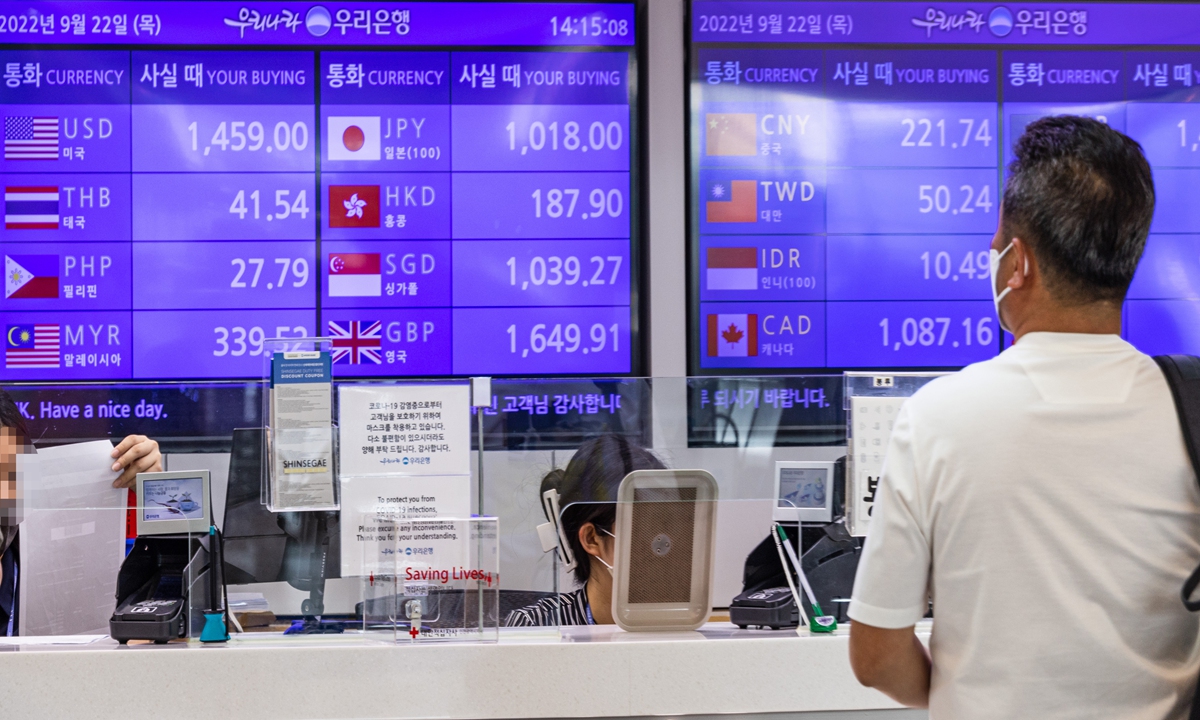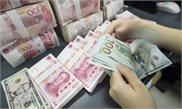
South Korean won falls to 1,400 per US dollar on September 23, 2022, touching a 13-year low following US Federal Reserve's rate hike. Photo: VCG
The US Federal Reserve on Wednesday raised its policy interest rate by 75 basis points (bps) for a third time in a row this year, in a desperate and reckless battle against rampant inflation.
The latest action that sank the US central bank deeper in the throes of the most aggressive rate-hiking cycle since 1981 was compounded by the Fed hinting more rate increases in the coming months, stoking fears of unbearable repercussions facing Washington in both economic and political terms.
Headlong rate hikes will likely push the US economy closer to an eventual recession, in defiance of the Fed's resolution to restore price stability, market watchers said.
The global economy at large, especially those with inadequate foreign exchange reserves and reliant on foreign loans for development, tends to take a battering from US' irresponsible monetary tightening moves, they noted.
A mix of inflation stubbornness and recession woes could be a headache for US President Joe Biden in the midterm elections, reckoned observers, who called attention to the possibility of the Biden administration playing geopolitical cards and expanding energy and farm produce exports as part of Washington's scapegoating attempts.
Key source of destabilization
While Wednesday's 75bps rate hike came in line with market estimates, remarks by Fed Chair Jerome Powell that hinted at more hawkish rate increases ahead evidently spooked the global markets.
At a press conference on Wednesday after the Fed's September monetary policy meeting, Powell said that "the median projection for the appropriate level of the federal funds rate is 4.4 percent at the end of this year, 1 percentage point higher than projected in June," citing the newest summary of economic projections.
The Wednesday rate decision brought the federal funds rate to a range of 3-3.25 percent. The Fed's projection of a continued upward spiral in its policy interest rate apparently points to more rate increases down the road, immediately dealing a blow to US stocks and sending shockwaves throughout the global markets.
All three major US stock indices gave up earlier gains in late sessions on Wednesday briefly after the Fed press conference, turning in across-the-board losses at the closing.
On Thursday, Asia-Pacific and European markets fell broadly on the Fed's absolute hawkishness. Chinese mainland and Hong Kong shares also posted broad losses, while the STAR 50 Index that encapsulates major innovative tech companies on the Shanghai STAR board bucked the overall trend to finish up 0.56 percent on Thursday.
The Fed is estimated to continue with its hawkish approach to raising interest rates within the year, Cheng Shi and Zhang Hongxu, economists with ICBC International, said in a research note sent to the Global Times on Thursday.
Despite signs of a slowdown in US rent growth and peaking in used car and truck prices, inflation remains primed to stick with the US, partly factoring in the spillover effect of an energy shortage threatening the eurozone this winter, the economists said.
This, adding to the Fed's optimism on the US job market - the US unemployment rate is projected to stay at 3.8 percent this year before climbing to 4.4 percent in 2023 - could make the case for another two rate increases adding up to a 150bps increase in the policy rate over the remaining two Fed monetary policy meetings this year - the November and December meetings, they continued.
Expectations are rising for an uptrend in inflation, particularly energy and food prices as the international situation remains obscure and the Russia-Ukraine tensions might intensify, Wu Jinduo, head of fixed income at the research institute of Great Wall Securities in Shanghai, told the Global Times on Thursday.
Additionally, the Fed might raise interest rates at a pace stronger than market expectations over the next year, analysts said, anticipating a tough mission for the Fed to shoot down the core inflation over the long run.
The Fed's latest projections indicated that the US might not shift to rate cuts until 2024, lengthening the previous forecast of a turnaround by almost a year.
Unbearable repercussions
The Fed's desperate rate-hiking moves added to the US economic woes and more worryingly put world economic stability at stake, observers said, blasting the US government over making the rest of the world the scapegoat for its reckless monetary decisions.
There's a growing chance of the US economy heading for a recession within the year, noted Wu, citing familiar precursors of a recession.
The US economy declined on an annualized basis in the second quarter, the second contraction in a row. The Yield curve inversion between 10-year Treasury bonds and 2-year bonds trends deeper, US stocks have lately been subject to greater swings and a correction in the commodity market continues, she went on to say, explaining that these data are proof of the market pricing in a recession.
The aggressive rate-hiking cycle underpins the US dollar strength while substantially weakening the Japanese yen and the euro, among other major currencies, Wu forecast. He noted that a stronger dollar will exacerbate the burden of foreign debt on the countries with insufficient foreign exchange reserves.
The Fed's drastic rate hikes, in addition to soaring inflation and geopolitical conflicts, put emerging market economies at risk of possibly the biggest shockwave in four decades, Liang Haiming, a Hong Kong economist and chairman of the China Silk Road iValley Research Institute, told the Global Times on Thursday.
Sri Lanka, Turkey, Egypt and other countries heavily dependent on foreign loans such as Tunisia and Ghana would be mired in rising costs of loaning, Liang said.
The Fed had previously resorted to quantitative easing and kept interest rates near zero as part of a push to revive the US economy amid the strong fallout of the pandemic, which resulted in a continued surge in inflation. As inflation becomes a singeing issue, the Fed has abruptly reversed course with continued rate increases and a reduction in its balance sheet, Liang remarked, lambasting US' irresponsible and mercurial monetary decisions that "bury huge time bombs" for notably emerging market economies.
Such undesirable repercussions could also boomerang on the Biden administration as the midterm elections are approaching, experts emphasized.
The US economy is still struggling to emerge from the pandemic, regardless of Biden's contentious announcement that the pandemic is over in the US.
Furthermore, high debt levels in the US, concerns over the US fiscal cliff and the likelihood of a US government shutdown, as well as the thorny inflation could well be a headache for the Biden administration ahead of midterms, Wu opined.
The Biden administration might seek to gain an upper hand through interference with geopolitical conflicts and an expansion of US energy and farm produce exports to balance trade and alleviate fiscal deficit, the analyst said, speaking of potential maneuvers on the part of the US to shift the attention away from its gaping domestic woes.
The latest action that sank the US central bank deeper in the throes of the most aggressive rate-hiking cycle since 1981 was compounded by the Fed hinting more rate increases in the coming months, stoking fears of unbearable repercussions facing Washington in both economic and political terms.
Headlong rate hikes will likely push the US economy closer to an eventual recession, in defiance of the Fed's resolution to restore price stability, market watchers said.
The global economy at large, especially those with inadequate foreign exchange reserves and reliant on foreign loans for development, tends to take a battering from US' irresponsible monetary tightening moves, they noted.
A mix of inflation stubbornness and recession woes could be a headache for US President Joe Biden in the midterm elections, reckoned observers, who called attention to the possibility of the Biden administration playing geopolitical cards and expanding energy and farm produce exports as part of Washington's scapegoating attempts.
Key source of destabilization
While Wednesday's 75bps rate hike came in line with market estimates, remarks by Fed Chair Jerome Powell that hinted at more hawkish rate increases ahead evidently spooked the global markets.
At a press conference on Wednesday after the Fed's September monetary policy meeting, Powell said that "the median projection for the appropriate level of the federal funds rate is 4.4 percent at the end of this year, 1 percentage point higher than projected in June," citing the newest summary of economic projections.
The Wednesday rate decision brought the federal funds rate to a range of 3-3.25 percent. The Fed's projection of a continued upward spiral in its policy interest rate apparently points to more rate increases down the road, immediately dealing a blow to US stocks and sending shockwaves throughout the global markets.
All three major US stock indices gave up earlier gains in late sessions on Wednesday briefly after the Fed press conference, turning in across-the-board losses at the closing.
On Thursday, Asia-Pacific and European markets fell broadly on the Fed's absolute hawkishness. Chinese mainland and Hong Kong shares also posted broad losses, while the STAR 50 Index that encapsulates major innovative tech companies on the Shanghai STAR board bucked the overall trend to finish up 0.56 percent on Thursday.
The Fed is estimated to continue with its hawkish approach to raising interest rates within the year, Cheng Shi and Zhang Hongxu, economists with ICBC International, said in a research note sent to the Global Times on Thursday.
Despite signs of a slowdown in US rent growth and peaking in used car and truck prices, inflation remains primed to stick with the US, partly factoring in the spillover effect of an energy shortage threatening the eurozone this winter, the economists said.
This, adding to the Fed's optimism on the US job market - the US unemployment rate is projected to stay at 3.8 percent this year before climbing to 4.4 percent in 2023 - could make the case for another two rate increases adding up to a 150bps increase in the policy rate over the remaining two Fed monetary policy meetings this year - the November and December meetings, they continued.
Expectations are rising for an uptrend in inflation, particularly energy and food prices as the international situation remains obscure and the Russia-Ukraine tensions might intensify, Wu Jinduo, head of fixed income at the research institute of Great Wall Securities in Shanghai, told the Global Times on Thursday.
Additionally, the Fed might raise interest rates at a pace stronger than market expectations over the next year, analysts said, anticipating a tough mission for the Fed to shoot down the core inflation over the long run.
The Fed's latest projections indicated that the US might not shift to rate cuts until 2024, lengthening the previous forecast of a turnaround by almost a year.
Unbearable repercussions
The Fed's desperate rate-hiking moves added to the US economic woes and more worryingly put world economic stability at stake, observers said, blasting the US government over making the rest of the world the scapegoat for its reckless monetary decisions.
There's a growing chance of the US economy heading for a recession within the year, noted Wu, citing familiar precursors of a recession.
The US economy declined on an annualized basis in the second quarter, the second contraction in a row. The Yield curve inversion between 10-year Treasury bonds and 2-year bonds trends deeper, US stocks have lately been subject to greater swings and a correction in the commodity market continues, she went on to say, explaining that these data are proof of the market pricing in a recession.
The aggressive rate-hiking cycle underpins the US dollar strength while substantially weakening the Japanese yen and the euro, among other major currencies, Wu forecast. He noted that a stronger dollar will exacerbate the burden of foreign debt on the countries with insufficient foreign exchange reserves.
The Fed's drastic rate hikes, in addition to soaring inflation and geopolitical conflicts, put emerging market economies at risk of possibly the biggest shockwave in four decades, Liang Haiming, a Hong Kong economist and chairman of the China Silk Road iValley Research Institute, told the Global Times on Thursday.
Sri Lanka, Turkey, Egypt and other countries heavily dependent on foreign loans such as Tunisia and Ghana would be mired in rising costs of loaning, Liang said.
The Fed had previously resorted to quantitative easing and kept interest rates near zero as part of a push to revive the US economy amid the strong fallout of the pandemic, which resulted in a continued surge in inflation. As inflation becomes a singeing issue, the Fed has abruptly reversed course with continued rate increases and a reduction in its balance sheet, Liang remarked, lambasting US' irresponsible and mercurial monetary decisions that "bury huge time bombs" for notably emerging market economies.
Such undesirable repercussions could also boomerang on the Biden administration as the midterm elections are approaching, experts emphasized.
The US economy is still struggling to emerge from the pandemic, regardless of Biden's contentious announcement that the pandemic is over in the US.
Furthermore, high debt levels in the US, concerns over the US fiscal cliff and the likelihood of a US government shutdown, as well as the thorny inflation could well be a headache for the Biden administration ahead of midterms, Wu opined.
The Biden administration might seek to gain an upper hand through interference with geopolitical conflicts and an expansion of US energy and farm produce exports to balance trade and alleviate fiscal deficit, the analyst said, speaking of potential maneuvers on the part of the US to shift the attention away from its gaping domestic woes.


